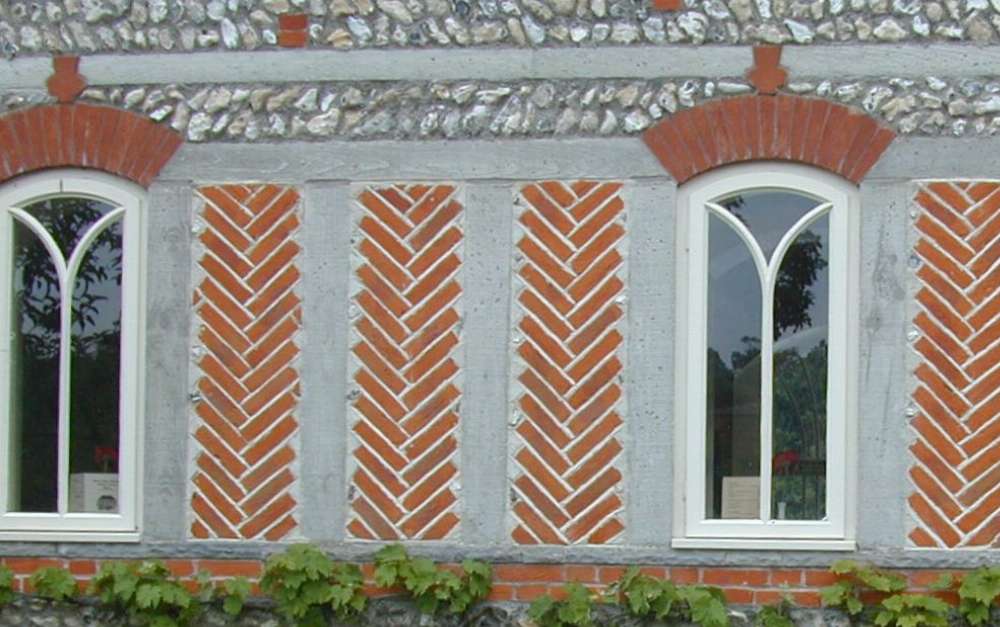
West Dean College Gardens Visitor’s Center: Exterior wall with exposed herringbone brick pattern, alternating with exposed concrete bands and grey flint stones
1994The exposed surface of the perimeter thick wall is made of a combination of red bricks, exposed concrete and flint stones. there are several patterns of alternating repetition, the predominant one being the alteration between concrete bands and the herringbone brick pattern, with windows in between. Above and below the windows are alternating horizontal bands in different widths, made of bricks, flint stone and concrete, all on top of a stepped red brick plinth. The local adjustments and variations are numerous, each one depending on its immediate surrounding elements.
Contents
-
West Dean College Gardens Visitor's Center - Exterior wall with exposed herringbone brick pattern, alternating with exposed concrete bands and grey flint stones: Sketches of material combinations
25/04/1995
Two sketches depicting two alternative design ideas for the entrance facade using different material combinations regarding the positioning of bricks and flint stones.
-
West Dean College Gardens Visitor's Center - Exterior wall with exposed herringbone brick pattern, alternating with exposed concrete bands and grey flint stones: Sketches of material combinations
02/05/1995
Two sketches depicting two design ideas for material combinations of the entrance facade: The first sketch shows the combination of concrete with flint stone infills; the second sketch shows the combination of concrete with brick and flint stone above the ...
-
West Dean College Gardens Visitor's Center - Exterior wall with exposed herringbone brick pattern, alternating with exposed concrete bands and grey flint stones: Sketches of the north wall
02/05/1995
Three partial elevations of the northern facade focused on material proportions and layouts around the small windows.
SEE ALL Drawings
-
West Dean College Gardens Visitor's Center - Exterior wall with exposed herringbone brick pattern, alternating with exposed concrete bands and grey flint stones: Photographs of samples
01/01/1994
Thirteen images of the flint stone depicting the variety of samples of the existing stone sizes, colors and availability. Displayed in an array of combinations as when embedded in a wall and including close-ups of various individual stone types .
-
West Dean College Gardens Visitor's Center - Exterior wall with exposed herringbone brick pattern, alternating with exposed concrete bands and grey flint stones: Photographs of mock-up
01/05/1994
Three images of early mock-ups of the exposed face of the wall, built on the project grounds and exploring what balance of the materials would best create the whole.
-
West Dean College Gardens Visitor's Center - Exterior wall with exposed herringbone brick pattern, alternating with exposed concrete bands and grey flint stones: Photographs of mock-up
01/05/1994
Three images of mock-ups for the entrance porch wall, with brick plinth, concrete and stone vertical bands and red brick herringbone inserts.
SEE ALL Photographs
References
-
Emergence of Geometric Order in Building Structure
Focusing primarily on the pure beauty of the geometric order, which comes, above all, from the building structure (columns, walls, beams, vaults and so forth), specifically from the aperiodic grids which form the abstract underpinning of the building structure.
-
Ornament and Function as Products of Unfolding
Ornament arises as part of the design process, when a person is making and seeks to embellish this "something" while making it. It arises as a result of the latent centers in the uncompleted thing requiring still more centers, requiring ...
-
Strong Centers in all Levels of Scale
A building can only amount to something as a living thing when the various physical elements which appear in it are profound centers. The dominant feature of the process that is working correctly is that new centers are formed, and ...
-
The Nature of Order - An Essay on the Art of Building and the Nature of the Universe.
Book Two - The Process of Creating Life
2002
“The Process of Creating Life”, the second volume of “The Nature of Order” series presents a dynamic theory of living structure. It begins with an analysis of transformations, which occur in nature, and the distinction between structure-preserving transformations, responsible for ...
-
The Nature of Order - An Essay on the Art of Building and the Nature of the Universe.
Book Four - The Luminous Ground
2004
“The Luminous Ground” is the fourth and last volume of “The Nature of Order” series. In this volume, Alexander attempts to show the cosmological underpinning of the nature of order. The book has two goals. First, to show that the ...
-
The Nature of Order - An Essay on the Art of Building and the Nature of the Universe.
Book Three - A Vision of a Living World
2005
“A Vision of a Living World”, the third volume of “The Nature of Order” series, presents, for the first time, a full spectrum of Alexander’s and CES built and unbuilt works. The book describes hundreds of buildings, plans, neighborhoods, drawings, ...
-
15. Emergence of Formal Geometry, 2 / Formation of Brutal and Massive Chunks in the Visitor Center at West Dean
-
Chapter 5. The Practical Matters of Forging a Living Center, 4 / Beings in Arches, Spaces and Columns: The Example of West Dean
-
Chapter 14. Construction Elements as Living Centers, 6/ Unfolding Building Details from the Fundamental Process
SEE ALL Book Chapters




 Go Back
Go Back